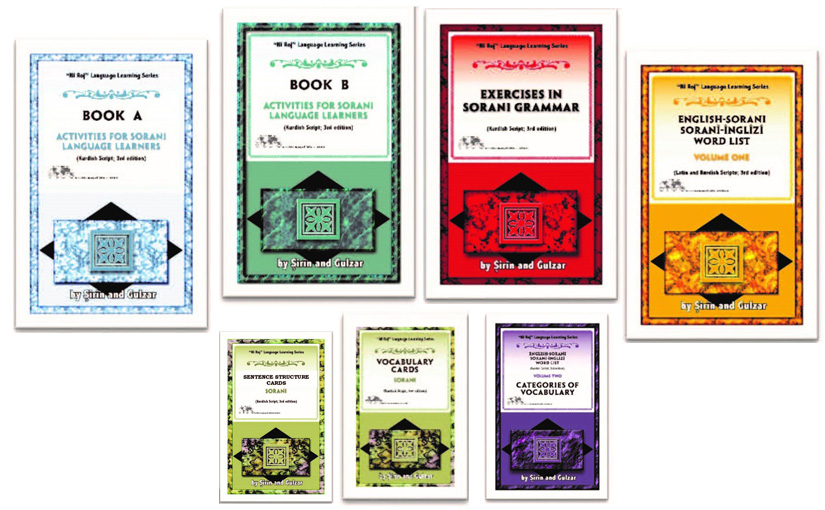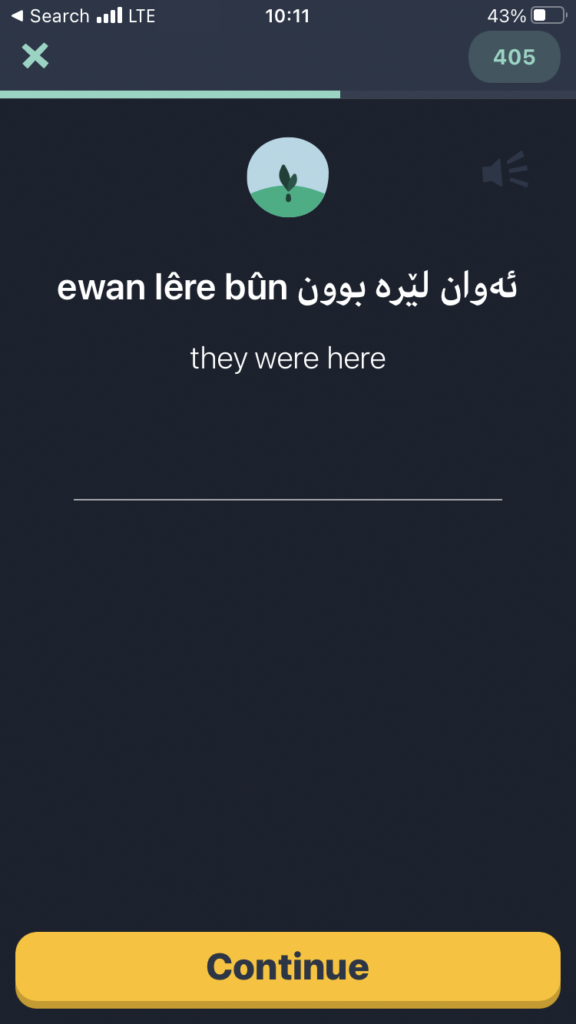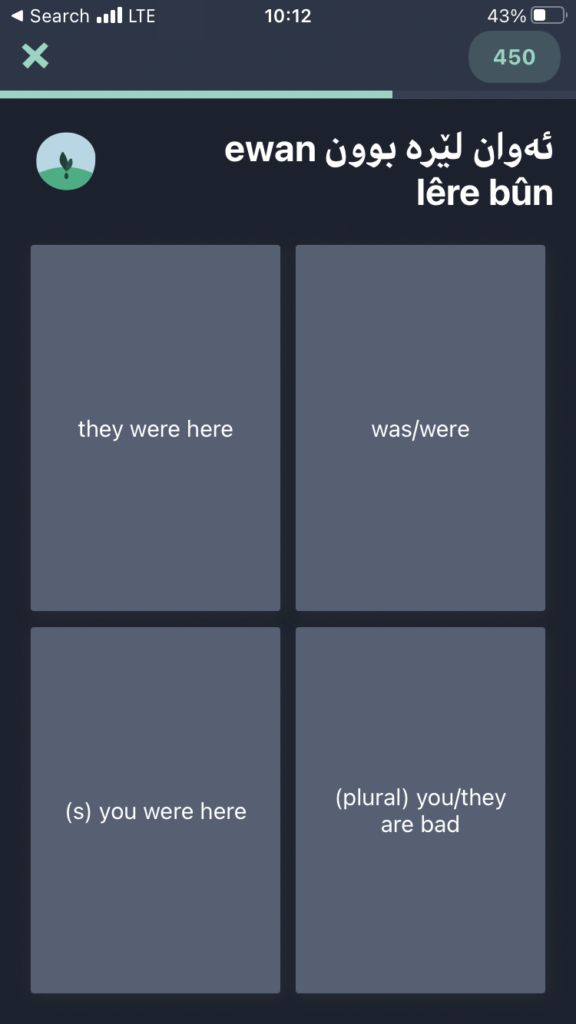Initial thoughts: It’s a goldmine…
Not many complete, self-guided courses are available in Sorani (Central) Kurdish. In fact, Sorani Kurdish “Complete Course”, Kurdish Script 3rd edition by Şirîn and Gulzar may be the only one. More than just a book, the Complete Course is a full suite of materials for learning Sorani Kurdish. It’s enormous, which is both its greatest strength and its main liability – when you first unpack the books or take them off the shelf it’s easy to be overwhelmed by the sheer volume.
The content itself is amazing: high quality, creative, practical, easy to use, and full of exercises and activities – exactly what most students of Sorani desperately want and struggle to find elsewhere. It also has the rare combination of digital audio and corresponding text. In particular, the introduction to the Kurdish script and the Grammar Exercises are the best available.
However, the organization of the course is somewhat confusing and could cause some users to give up in frustration. On the one hand, it feels incredibly organized: detailed instructions and cross references lead learners through the course. But at the same time it feels like a maze: there are multiple books, some of which read from both right-to-left and from left-to-right and contain multiple sections.
This Sorani course is a goldmine for language learners, but it’s a goldmine that they could get lost in. This review offers a “map to the goldmine”.
In short, this Sorani course is a goldmine for language learners, but it’s a goldmine that they could get lost in. I wouldn’t want anyone to miss out on the good things this course has to offer, so I hope that this review will provide a “map to the goldmine”, empowering you to venture into the Sorani Kurdish “Complete Course” and return safely with treasure in hand. Every serious Sorani Kurdish learner can benefit from drawing on these materials.
A few additional general notes:
The Kurdish script is used in most sections of this course, but the curriculum assumes that learners do not know the Kurdish script when they start. As an aid, the first few sections use the Latin script that is used to write Kurmanji (Northern Kurdish) in Turkey. Since Latin script is used for English, English speakers will be able to pronounce many sounds immediately using this script. But there are also fifteen letters that represent new sounds or different sounds compared to English. If you are familiar with one of these alphabets and find the other confusing, see this comparison of Kurdish alphabets.
A few typos or errors can be found in these materials. As this is the case with almost all Sorani learning materials currently available, this shouldn’t be the deciding factor in whether or not students use this course.
The Complete Course is available at Amazon or by emailing: books.kiteb “at” gmail.com
How this review is organized
Because this Sorani course is so extensive, there’s a lot to say. Here’s where we’re headed in this review (click the links to jump to a section):
First, we’ll take a look at what’s included with the Sorani Kurdish “Complete Course”, giving an overview of the materials that you get when you purchase it. Then we’ll try to explain how the course is designed by taking a step back for the big picture of how the various materials fit together. Next, I outline two different approaches to using the materials. The first is to use the “Language Learning Progress Chart” included with the course, and I have provided tips that will help make using the chart easier. The second approach is to pick and choose to supplement your learning and specific sections are recommended for different kinds of learners. Finally, you’ll find a section-by-section review of Books A and B.
What’s included with the Sorani Kurdish “Complete Course”?
The full set of materials includes: six books, digital audio recordings to accompany them, reference cards, and flashcards. The materials are attractive and high quality, and books are spiral bound for easy use during study. The course is available at Amazon or by emailing: books.kiteb “at” gmail.com.
Here is what you get with the Complete Course:
Book A and Book B – Two of the main books of the curriculum, these include tips on language learning and culture, how to write the Kurdish script, grammar, listening, writing, stories, and more. See “How do I get started?”, and the section-by-section review of Books A and B, for more details.
Exercises in Sorani Grammar – The third main book of the curriculum, this book provides clear explanations for all main points of Sorani grammar. After each point examples and exercises are provided, using the Kurdish script. This is one of the best resources in the curriculum.
English-Sorani, Soranî-Înglîzî Word List and Categories of Vocabulary – These two books include the Sorani words that you’ll encounter in the course materials. The first is a basic bilingual dictionary while the second could be useful for brainstorming groups of similar words to learn together in a language lesson.
Vocabulary Cards – Flashcards for the 600 words from the wordlist books that are most frequently used. The materials sold on Amazon say that these are included electronically but I’ve also seen them as physical cards in a nice box.
Grammar Reference Cards – Provide a brief, visual summary of key grammar points as a reference.
Sentence Structure Cards (unbound) – These were not available to me at the time of writing this review.
Digital Audio Recordings for Books A & B – 95% of this audio was recorded by a native Sorani speaker. Please note that Kurdish Central has received permission to host the audio for the Sorani Kurdish “Complete Course” on our website!
Understanding how the course is designed
The meat of the course is found in three books: Book A and Book B, both of which are subtitled Sorani Language Learning Activities, and Exercises in Sorani Grammar. This is where things could get confusing… Books A & B aren’t designed to be gone through from start to finish. They are composed of multiple sections that are somewhat independent of one another – Books A & B are really collections of materials bound together. Exercises in Sorani Grammar is another giant “section” that accompanies them. Each section is designed to help learners work on specific skills, like: the Kurdish script, pronunciation, listening, grammar, and vocabulary. The trick is getting a handle on what is included with the course and identifying the parts that will be most helpful in meeting your goals.
Books A & B are composed of multiple sections that are somewhat independent of one another – they are really collections of materials bound together. Exercises in Sorani Grammar is another giant “section” that accompanies them.
How do I get started?
Here are two approaches or “maps to the goldmine” that could help you get started. No matter which approach you choose, I highly recommend putting tabs on all of the sections in Book A and Book B before you do anything else. Besides making it easier to find what you’re looking for each time you open the books, it will also help you become familiar with the curriculum’s organization by allowing you to see at a glance what’s in each book.
Approach #1: Use the “map” included with the course
The authors have included their own syllabus, guiding students through the Sorani course. It’s found in the first section of Book A and called the “Language Learning Progress Chart”. Start on page 1 of Book A which lists some important preparatory work to complete before diving into the “Progress Chart” itself. Basically learners are meant to familiarize themselves with the materials, learn the Kurdish script, get an overview of the grammar, and lay the foundation for the meat of the course which is laid out in the “Progress Chart”.
Decoding the “Language Learning Progress Chart”
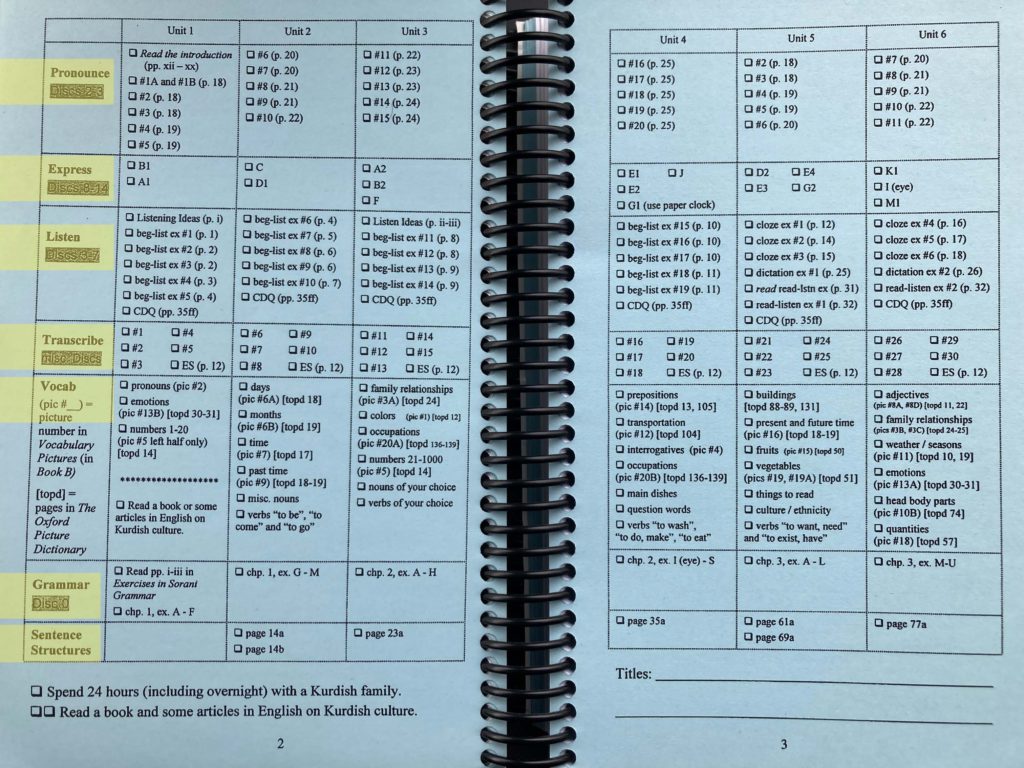
The first pages of the “Progress Chart” are shown in the picture above. It took me some digging through Books A and B to understand what it means because it uses abbreviations extensively. Here are some tips and clarifications about the chart that will be helpful for first time users. Referring to the section headings, highlighted in yellow in the picture above:
- Pronounce = “Pronunciation Exercises” found in Book A.
- Express = “Expressions” found in Book A.
- Listen = “Listening Exercises” found in Book A. The other abbreviations (beg-list ex, CDQ, etc.) refer to subsections that are listed in the table of contents at the beginning of the “Listening Exercises” section.
- Transcribe = “Transcription Exercises” found in Book A.
- Vocab (No additional note here because abbreviations are defined in the chart.)
- Grammar = Exercises in Sorani Grammar. This is the title of an additional book and is not to be confused with the “Grammar Overview” found in Book B. (The “Grammar Overview” is meant to be completed as a preliminary task, before starting the “Language Learning Progress Chart”.)
- Sentence Structures = May refer to the sentence structure cards, but these were not available to me so I wasn’t able to verify this…
Color-coded guide to Book A and Book B sections
The sections of Books A & B can be visualized by dividing them into three types, following Approach #1:
- Sections that are to be completed as part of the important preparatory work described in Book A, on page 1 of the “Language Learning Progress Chart”. (Green in the table below.)
- Sections that are found in the “Language Learning Progress Chart”, on pages 2-7 of Book A. (Blue in the table below.)
- Answer keys. (White in the table below.)
These three types of sections can be seen in the color-coded table of contents for the two books, below (this chart is based on the third edition).
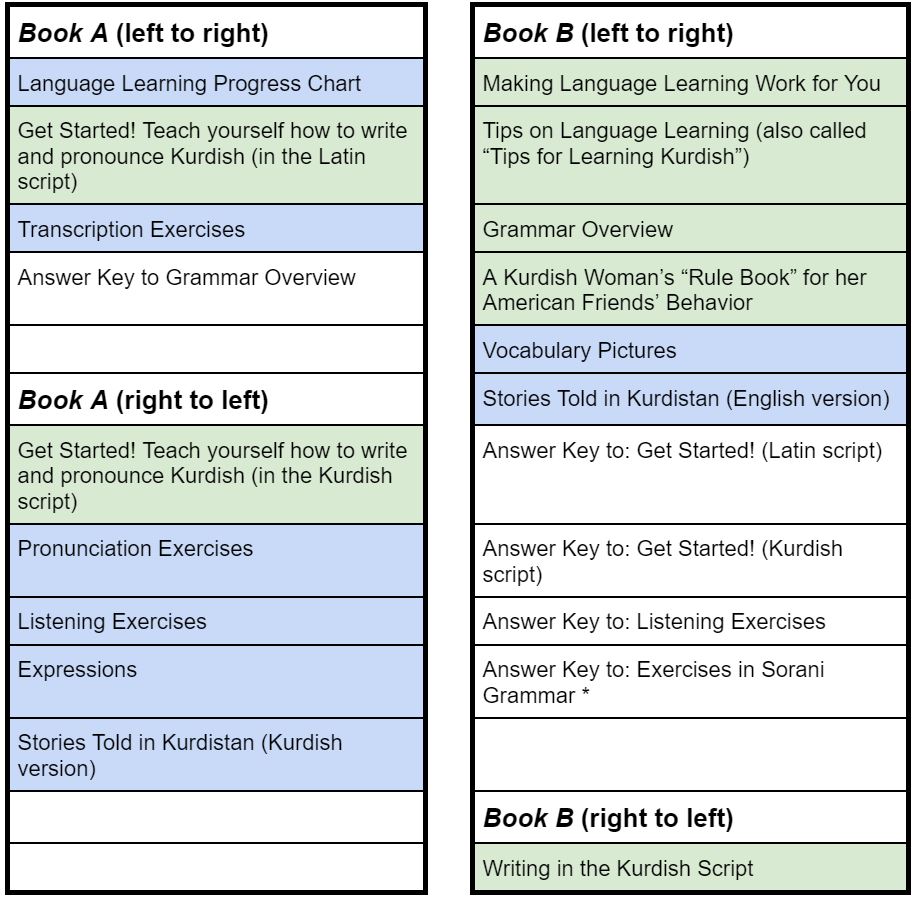
* The Book B table of contents lists this as being the first section going right to left, but in fact it’s the last section going left to right.
Approach #2: Pick and choose to supplement your learning
Even if you decide not to commit to the entire curriculum described in the “Language Learning Progress Chart”, it would be a shame not to draw on these materials. To facilitate that, here are the sections that I think are the most valuable. I recommend that you familiarize yourself with them and incorporate them into your Sorani learning plan. For more details on each, and for information on the sections that I haven’t listed here, refer to the “Section-by-section review of Book A and Book B”, below.
Exercises in Sorani Grammar
Everyone can benefit from the clear explanations and extensive exercises found in Exercises in Sorani Grammar. The basic outline of the books is identical to the Latin script “Grammar Overview” found in Book B, but it is much more in depth and uses the Kurdish script for examples and exercises.
This book explains all of the key points of Sorani grammar. Rules for each structure are presented in simple “grammar notes” and these are keyed to the Grammar Reference Cards which are included with the course. Examples and exercises follow each new grammar point to help learners understand and internalize it. If you use only one part of the Complete Course it should be the Exercises in Sorani Grammar.
If you use only one part of the Complete Course, it should be the Exercises in Sorani Grammar.
The best sections from Books A & B
Note that the section and page numbers given are from the 3rd edition of Complete Course. If you have a different edition the order of sections or page numbers is probably different.
- “Pronunciation Exercises” – Learn to say Sorani Kurdish sounds that are difficult for English speakers. Book A, Right – Left, 2nd section.
- “Listening Exercises: Reading – Listening Exercises” – Improve listening, reading, speaking, and build vocabulary using ten “Stories Told in Kurdistan” and other recommended resources. Book A, Right – Left, 3rd section, Page 29.
- “Listening Exercises: Cultural Discussion Questions” – Questions to start conversations about culture. Book A, Right – Left, 3rd section, Page 35.
- “Expressions” – Common phrases and dialogues in Sorani with English translation. Book A, Right – Left, 4th section.
- “Stories Told in Kurdistan (Kurdish version)” – These ten stories with recordings and English translations are best used as part of the “Listening Exercises: Reading – Listening Exercises”. The stories themselves are found in: Book A, Right – Left, 5th section.
- “Grammar Overview” – Quick but complete grammar introduction in Latin script with exercises. Book B, Left – Right, 3rd section.
- “A Kurdish Woman’s “Rule Book” for her American Friends’ Behavior” – These brief cultural notes are eye-opening. (Useful for non-Americans as well). Book B, Left – Right, 4th section.
- “Writing in the Kurdish Script” – One of the best resources for learning to write the Kurdish script. Book B, Right – Left, 1st section.
How to use the best sections from Books A & B
For the beginner:
- “A Kurdish Woman’s “Rule Book” for her American Friends’ Behavior” Book B, Left – Right, 4th section.
- “Writing in the Kurdish Script” Book B, Right – Left, 1st section.
- “Pronunciation Exercises” Book A, Right – Left, 2nd section.
- “Grammar Overview” Book B, Left – Right, 3rd section.
- “Expressions” Book A, Right – Left, 4th section.
For use with a language helper or in language lessons:
- “Listening Exercises: Reading – Listening Exercises” Book A, Right – Left, 3rd section, Page 29.
- “Listening Exercises: Cultural Discussion Questions” Book A, Right – Left, 3rd section, Page 35.
- “Expressions” Book A, Right – Left, 4th section.
Section-by-section review of Book A and Book B
A lot of material is available in Book A and Book B. Here is a quick overview of the sections including why I do or don’t recommend each one. Note that the answer key sections have been listed without any comments. The sections that seem most helpful are listed in “The best sections from Books A & B”, above. These “Best sections” are indicated below with an asterisk (*).
The section and page numbers given are from the 3rd edition of Complete Course.
Book A (left to right)
Language Learning Progress Chart
Book A, Left – Right, 1st section
The “Language Learning Progress Chart” is a suggested study plan for the curriculum, leading students systematically through the main elements of the course. For more on this see the review section, above, “Decoding the “Language Learning Progress Chart”.
Get Started! Teach yourself how to write and pronounce Kurdish (in the Latin script)
Book A, Left – Right, 2nd section
The goal of this section is to become familiar with the sounds in the Kurdish language and to learn to correctly identify them. Learners will listen to recordings of wordlists and dialogues and answer questions based on them on the worksheets provided. Note that the title of the section includes “write” and “pronounce” but these skills aren’t the main emphases of the section.
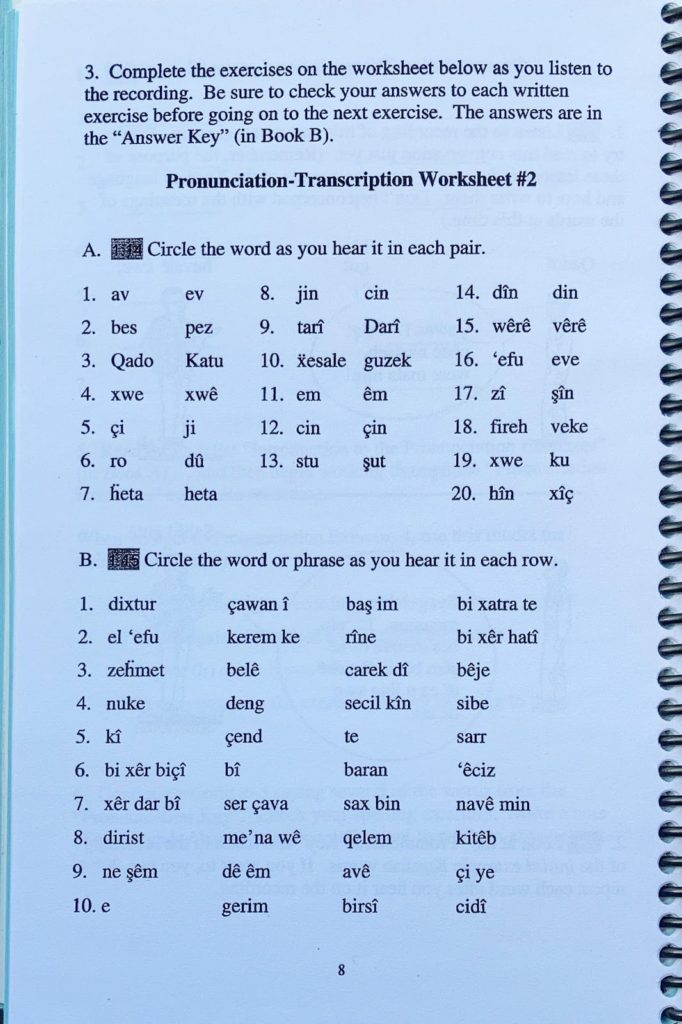
For Sorani learners there’s a big downside to this section in that it uses examples from Behdini Kurdish rather than Sorani. Sounds in the two Kurdish varieties are very similar but there are pronunciation differences for vowels and significant differences in vocabulary. Additionally, the recordings for this section are some of the only ones in the curriculum spoken by a non-native Kurdish speaker. For those completely unfamiliar with the sounds in Kurdish, this section could be helpful, but those who are picking and choosing might consider skipping it.
Also note that content, wordlists, examples, etc. in this section and “Get Started! Teach yourself how to write and pronounce Kurdish (in the Kurdish script)” are identical and use the same recordings. The only difference in the two sections is the script used to write Kurdish. This section, which uses the Latin script (like English) might be easier for learners who want to focus on learning Kurdish sounds without the additional challenge of the Kurdish script.
Transcription Exercises
Book A, Left – Right, 3rd section
The goals of this section are to practice writing in the Kurdish script and to continue to improve in identifying Sorani Kurdish sounds. Some of the exercises suggest activities that can be done with a language helper. In others, learners transcribe one of the recordings included with the curriculum and then check their work by looking at the correct transcription.
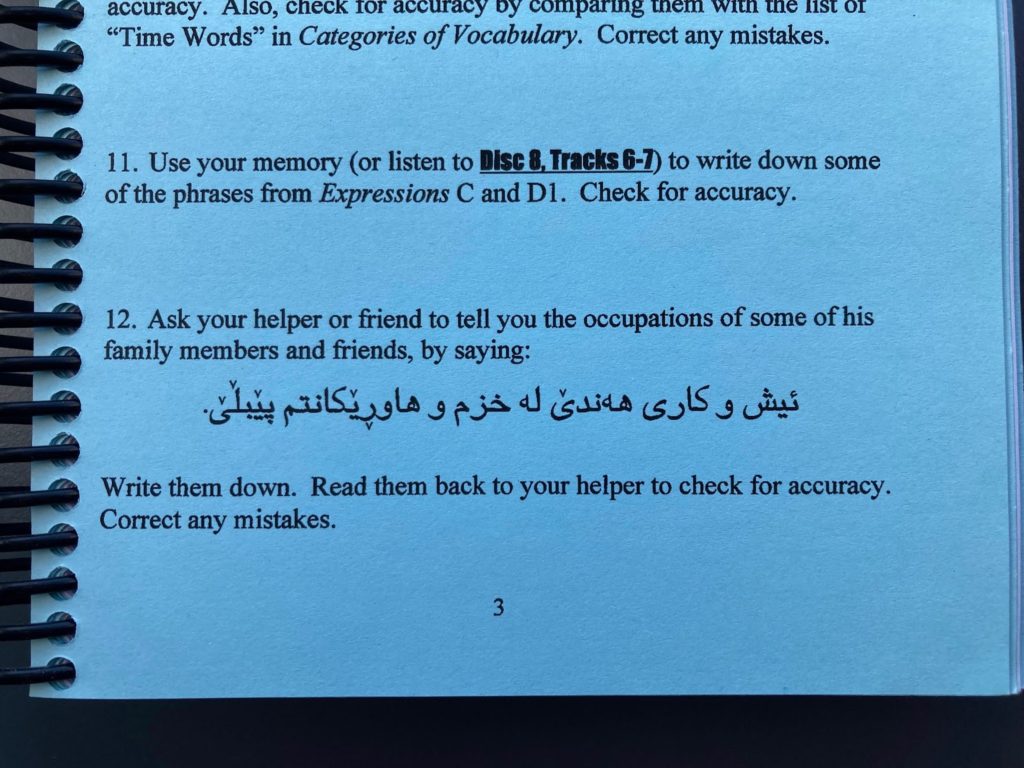
Book A (right to left)
Get Started! Teach yourself how to write and pronounce Kurdish (in the Kurdish script)
Book A, Right – Left, 1st section
Comments from the review of “Get Started! Teach yourself how to write and pronounce Kurdish (in the Latin script)” apply here as well. The difference in this section is that it’s entirely in the Kurdish script. Since this section uses Behdini, Sorani learners might look elsewhere for help with pronunciation.
* Pronunciation Exercises
Book A, Right – Left, 2nd section
The goal of this section is proper pronunciation of Sorani Kurdish. The first twenty pages of the section provide helpful information about articulatory phonetics, or how we use our mouths to produce various sounds. Attention is given to each sound in Sorani with tips for producing those that are likely to be difficult for English speakers. Then each sound is reinforced by audio recordings of carefully curated wordlists. Of particular help are the exercises that contrast pairs of sounds that are difficult or easy to confuse. I haven’t seen material similar to these pronunciation exercises anywhere else and I think they are well worth every Sorani learner’s time.
Listening Exercises
Book A, Right – Left, 3rd section
This section includes activities to help you practice carefully listening to Sorani. It begins with some great suggestions for topics and Kurdish phrases that you can use to get friends talking about their lives. The following types of exercises follow:
Beginning Listening Exercises – Fill in the blanks with a missing letter or word while listening to a recording. (Suitable for very beginners).
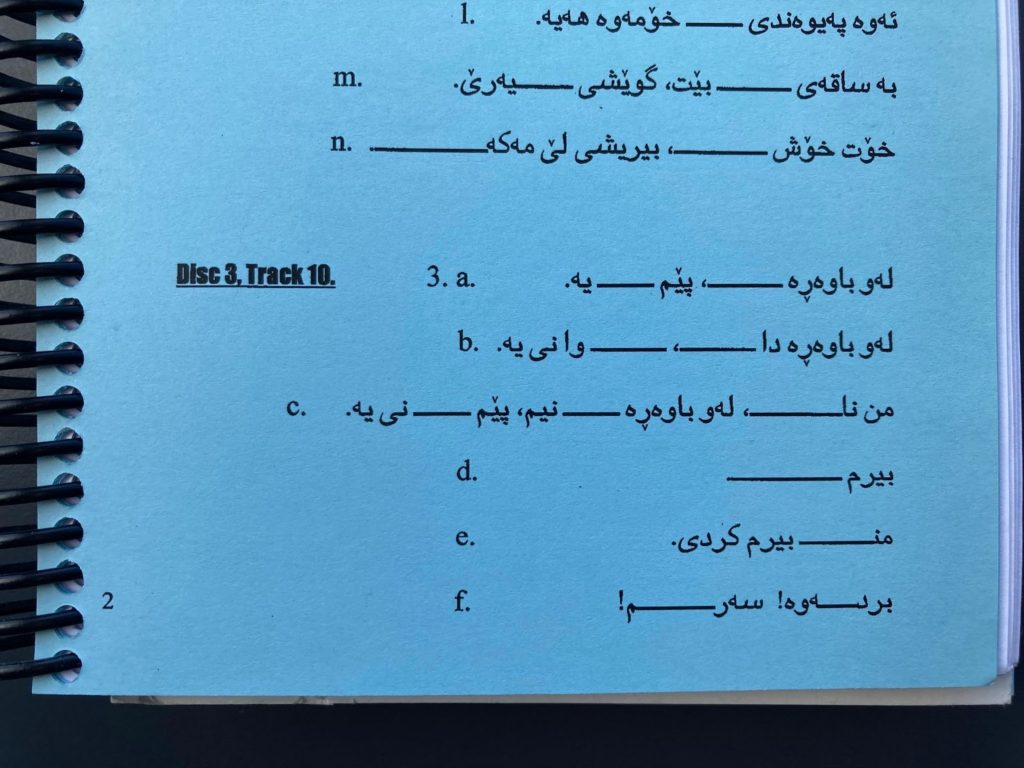
Listening Cloze Exercises – Listen to longer texts and songs and fill in the blanks with missing words. (Suitable for beginners).
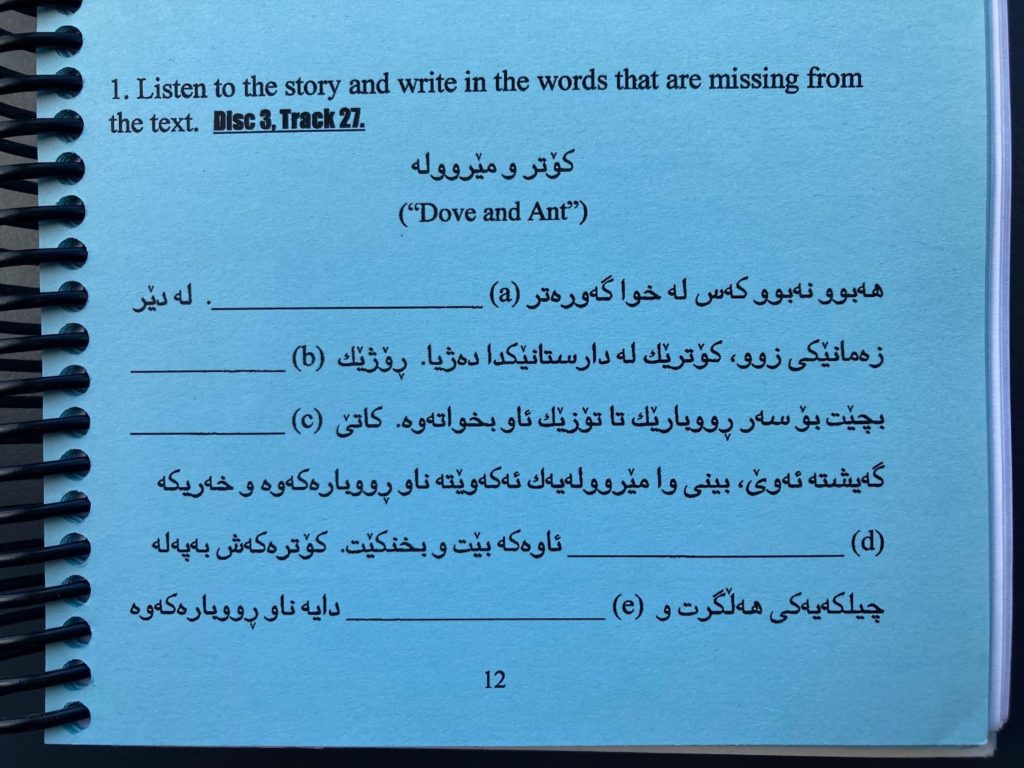
Dictation Exercises – Listen to and transcribe several sentences, then check work. (Suitable for more advanced beginners).
* Reading – Listening Exercises – Listen to, read, study, and retell the ten Stories Told in Kurdistan. These exercises are fantastic – they will help you improve listening, reading, build vocabulary, improve speaking, and build confidence. A list of other possible listening materials is also included. (Suitable for advanced beginners).
* Cultural Discussion Questions – Dozens of questions that will get Kurdish friends talking, help you learn the language and culture, and get to know someone better. This section is a must-use for language lessons. Questions are all provided in English and Sorani to help you get started. (Suitable for advanced beginner or intermediate learners).
* Expressions
Book A, Right – Left, 4th section
This section helps you master common phrases and conversations while continuing to improve pronunciation. It’s organized topically. Each topic has recordings and written transcriptions of key phrases and conversations. English translations are provided line by line in the book.
A few of the topics are: Getting started with your language helper, Greetings and farewells, Weather and seasons, Medical expressions, Idioms, and Tongue Twisters (and there are many more).
* Stories Told in Kurdistan (Kurdish version)
Book A, Right – Left, 5th section
Audio recordings of these ten stories are included as well as the Kurdish text and English translation (the English versions are in Book B). These stories are a good resource for listening, reading or transcription practice.
Book B (left to right)
Making Language Learning Work for You
Book B, Left – Right, 1st section
Many practical tips on language learning. It’s worth reading through this section – you might not adopt all of the ideas but you’ll come across something that will help you in your Kurdish learning journey.
Tips on Language Learning (also called “Tips for Learning Kurdish”)
Book B, Left – Right, 2nd section
Rather than presenting tips that are specific to learning Kurdish, the content in this section applies generally to students of any language. Included are the helpful sections “Ideas for Cultural Research”, which would be good topics for time with a language tutor, and a “Language Proficiency Self-Check” which is a good tool for gauging progress and giving you ideas about what to focus on to get to the next level.
* Grammar Overview
Book B, Left – Right, 3rd section
Several reference grammars are available for Sorani Kurdish but the grammar resources in this course may be the best thing available for students who want to learn the language. This overview includes clear, thorough explanations as well as helpful exercises. Grammar is taught here entirely in Latin script (the accompanying book Exercises in Sorani Grammar uses Kurdish script and is more thorough).
* A Kurdish Woman’s “Rule Book” for her American Friends’ Behavior
Book B, Left – Right, 4th section
This section highlights some of the differences between Kurdish culture and American culture, which will also be enlightening for non-Americans. It’s concise and a few minutes of reading will help you understand your Kurdish friends better and possibly save you from miscommunications or cultural blunders.
Vocabulary Pictures
Book B, Left – Right, 5th section
These pictures are similar to Lexicarry or those found in the Growing Participator Approach (GPA) Phase 1 packet. and are designed to be used to elicit and learn vocabulary during language lessons.
Stories Told in Kurdistan (English version)
Book B, Left – Right, 6th section
This is the English translation of “Stories Told in Kurdistan (Kurdish version)”, found in Book A.
Answer Key to: Get Started! (Latin script)
Book B, Left – Right, 7th section
Answer Key to: Get Started! (Kurdish script)
Book B, Left – Right, 8th section
Answer Key to: Listening Exercises
Book B, Left – Right, 9th section
Answer Key to: Exercises in Sorani Grammar
Book B, Left – Right, 10th section
Book B (right to left)
* Writing in the Kurdish Script
Book B, Right – Left, 1st section
For many Sorani Kurdish students one of the first big hurdles is learning the Kurdish script. This section is invaluable and should be incorporated into everyone’s learning strategy. What sets it apart from other resources is that the “stroke order” – where to place the pen to start and which direction to move it – is shown step by step for each letter. Exercises are provided after each lesson to practice the letters learned so far. Some of the Kurdish words used in the examples are from Behdini, but I don’t find this to be a disadvantage for learning the script (as I did with pronunciation). The final exercises, after the full alphabet has been learned, draw on Sorani only.

